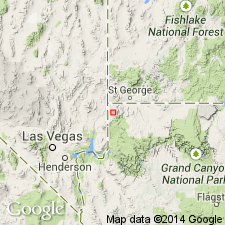
- Usage in publication:
-
- Solitude granite*
- Modifications:
-
- First used
- Dominant lithology:
-
- Granite
- AAPG geologic province:
-
- Southwestern Basin-and-Range region
Summary:
First published use for a granite that occurs in three areas on geologic map of Globe quad--one body mapped between Black Warrior and Continental mines, T1N, R14E, and two bodies at head of Solitude Gulch [source of geographic name], T1S, R15E. All three occurrences are in the Southwestern Basin-and-Range region, Gila Co, AZ. No type locality designated. Is a light-gray to white muscovite granite that weathers yellowish. Is massive and usually even granular; the average size of the grains is about 5 mm. Andalusite seen in thin sections. Is intrusive into the Pinal Schist. Bodies on Solitude Gulch are cut by porphyry dikes of the Schultze granite (first used). Considered to be of pre-Cambrian age and older than the Schultze.
Source: GNU records (USGS DDS-6; Denver GNULEX).

- Usage in publication:
-
- Solitude Granite*
- Modifications:
-
- Age modified
- AAPG geologic province:
-
- Southwestern Basin-and-Range region
Summary:
Age modified from Late Cretaceous or early Tertiary to Precambrian X or Y. Its K-Ar ages of 62.3 +/-1 m.y. (biotite) and 71.7 +/-1 m.y. (muscovite) were partly reset by the 61 m.y. Schultz Granite. Intrudes Pinal Schist. Its position in the district (Southwestern Basin-and-Range region) is enigmatic. Lithologic correlation difficult. Is a two-mica-granite in some areas and a muscovite granite in others. Geologic map. Cross section.
Source: GNU records (USGS DDS-6; Denver GNULEX).
For more information, please contact Nancy Stamm, Geologic Names Committee Secretary.
Asterisk (*) indicates published by U.S. Geological Survey authors.
"No current usage" (†) implies that a name has been abandoned or has fallen into disuse. Former usage and, if known, replacement name given in parentheses ( ).
Slash (/) indicates name conflicts with nomenclatural guidelines (CSN, 1933; ACSN, 1961, 1970; NACSN, 1983, 2005, 2021). May be explained within brackets ([ ]).

